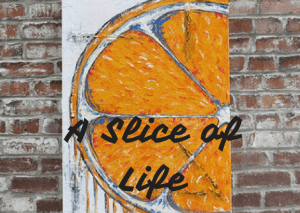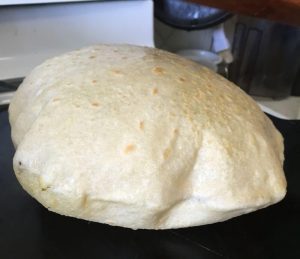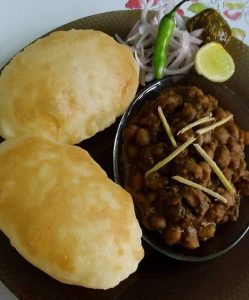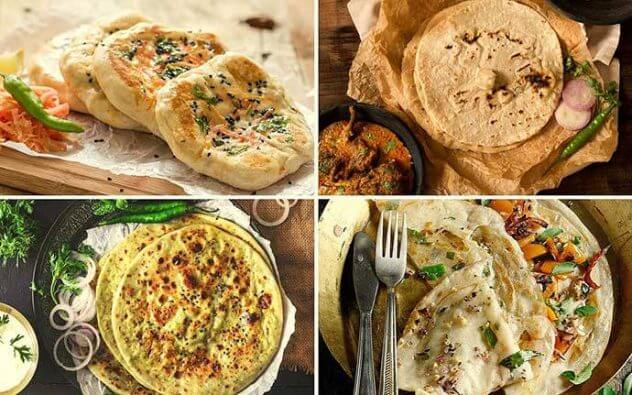Reading Time: 4 minutes
Ruchira tells us the story of breads, it’s origin and history. An exclusive for Different Truths.


A staple food item throughout the Indian subcontinent, Chapatti today has strong global presence owing to emigration of indigenous people to various parts of the world.
A staple food item throughout the Indian subcontinent, Chapatti today has strong global presence owing to emigration of indigenous people to various parts of the world. One version says that the name is derived from the Sanskrit word rotika meaning bread. Another source says the name probably sprang from chapat (vernacular for slap). Traditionally the dough (minus yeast which helps it rise) was divided in small rounds, by slapping it between the wet palms of the hands. With each slap, the dough rotated and grew a tad bigger. Next, each blob of dough was rolled into circular pieces with the help of a rolling pin and board. Then each bit was heated on a griddle (tawa) or directly over an open flame. However, in the tandoori method the rolling was omitted. The cooks persisted in slapping each piece of dough until it got fairly enlarged, following which it was firmly pasted on the interior wall of a blazing clay oven (tandoor) for a thorough baking. This process remains popular even to this day.
The Chapatti popularly hailed as Roti, with its myriad forms, shapes and sizes, holds sway over people’s hearts and minds. The immense variety is stunning. A touch of ground reality. Wheat flour contains a bevy of essential nutrients like carbs, fibres vitamins and minerals. Hence its consumption was mandatory for survival and good health. However, the mercurial human mind sought a break from the routine straight jacketed diet pattern. This explains the development of divergent ways to make the basic wheat dough more palatable and likeable.
The plain and simple roti serves as a perfect accompaniment for all kinds of vegetables (well, almost) egg and poultry, mutton et al. Honestly, it does not jell with fish and sea food as all consumers of the two categories jolly well know.
Back to the topic The plain and simple roti serves as a perfect accompaniment


for all kinds of vegetables (well, almost) egg and poultry, mutton et al. Honestly, it does not jell with fish and sea food as all consumers of the two categories jolly well know. Flipped on a hot plate with a smattering of oil or ghee (clarified butter) it becomes a Paratha. There are two types of parathas –plain skimpy ones as well the ones stuffed with onion, radish carrot, fenugreek (methi) leaves, cauliflower and what have you!
It would be criminal to overlook the Pooris which are a gourmand’s delight. Deep fried in oil they taste heavenly, and leave you thrilled, provided you momentarily ignore your girth.
Another bread option is the Kulcha. In this case, the basic ingredient is maida flour which is kneaded with milk or yogurt instead of water. A pinch of salt is added along with a minuscule portion of yeast.
Another bread option is the Kulcha. In this case, the basic ingredient is maida flour which is kneaded with milk or yogurt instead of water. A pinch of salt is added along with a minuscule portion of yeast. The dough is then covered with a wet cloth and left to stand for some time in a warm place. This results in a slight leavening of the flour. Later the dough is baked in a tandoor. For all practical purposes Kulchas may be plain or even stuffed with vegetables and mincemeat, as per individual taste.
Onward to the oiliest bread of all, the Bhatura. Possibly of Punjabi origin it appears to be garnering popularity countrywide. The ingredients include e maida, curd/ yoghurt, ghee, and yeast/ baking powder. Kneading over, the dough is set aside to rise. After a stipulated period of time, small balls are made out of it. These are rolled manually or with a rolling pin. Later each d piece is deep fried until it puffs up into a lightly browned, soft, fluffy mass s elastic and chewy in taste. The Bhatura akin to its cousin the Kulcha is best consumed with chhole (aka chick peas/ garbanzo beans). However the gravy ought to be thick and tight. A soupy or running gravy is an absolute no-no.
I have a tremendous soft corner for the chole bhature combo. To me it is by far the tastiest item of Punjabi/North Indian cuisine.


Personally speaking, I tend to avoid tandoori rotis because I find them rather tough to tear and chew. Yes, even the most well baked ones, trust me. I simply look on while my family members savour the fruits of the oven. However, I have a tremendous soft corner for the chole bhature combo. To me it is by far the tastiest item of Punjabi/North Indian cuisine. Passing by any chhole bhature joint on my way anywhere, I have a tough time not yielding to temptation and dragging myself away. Even so the strong aroma that wafts out is enough to make me drool…
Photos from the Internet















